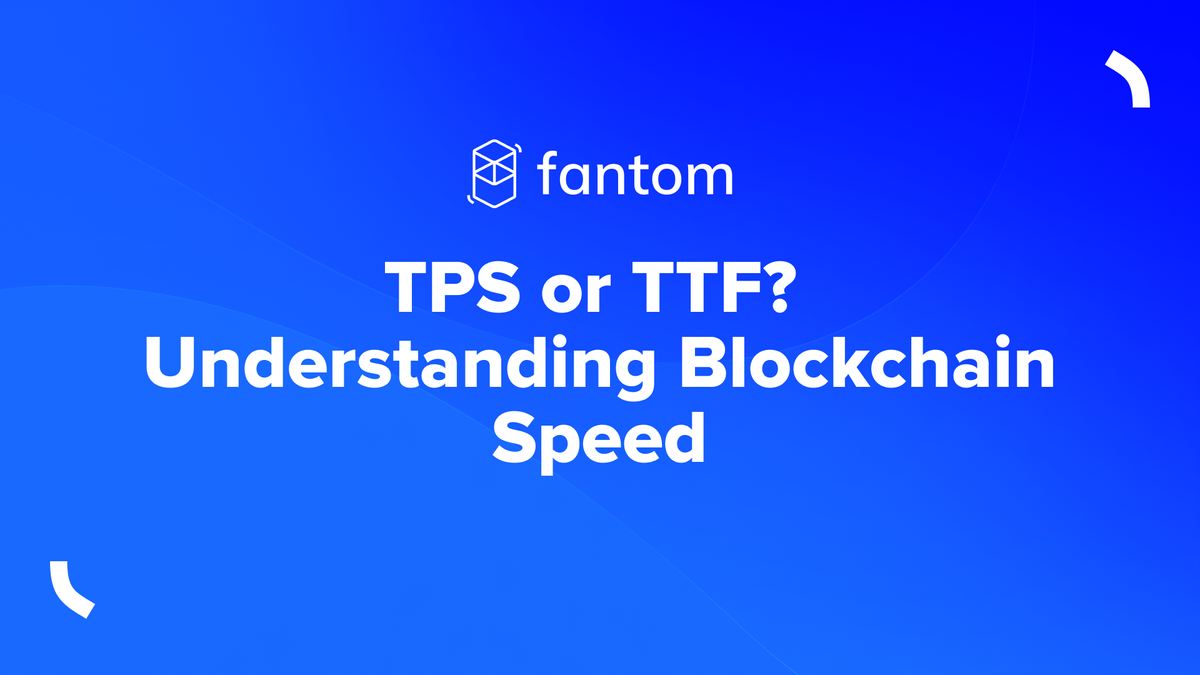TPS or TTF? Understanding Blockchain Speed

TPS or “Transactions per second” is the first metric mentioned in almost any discussion of blockchain projects and, for many, the barometer of success for Layer-1 protocols.
In this article, we give an overview of what TPS is, how to calculate it and highlight the reasons why it's a problematic and frequently inaccurate measure of blockchain speed. As we lay out terms, we will explain why Fantom is the fastest public blockchain in crypto.
What is TPS?
TPS is defined in Database systems. In its broader usage, the term measures how many transactions occur in one second in a given information system. For reference, on a typical day, the Visa Network processes approximately 1400 TPS.
For blockchain protocols, TPS is calculated by dividing the average number of transactions per block by the block time in seconds:
TPS = No. txn. per block ÷ Block time in seconds
Here, the number of transactions per block can be estimated by:
No. txn. per Block = Block size in bytes ÷ average txn. size in bytes
Examining the above, one might ask about what counts as a transaction. Different projects have rationales for defining what qualifies as a transaction, and the answer may vary by protocol. Some projects even count internal messages in their systems as transactions.
One might also note that TPS deals with averages. In real-life, some transactions, like simple balance transfers, take far less time to process than EVM-based smart contract transactions, which take measurably longer.
The overall lack of standardization already indicates the problems with the expression as a gauge of speed.
Why TPS is a faulty metric
If a blockchain is capable of 7 TPS, like Bitcoin, does this mean that our transaction will be quickly executed and confirmed at a moment of extremely low network traffic? Experience demonstrates otherwise.
TPS does not account for the total duration during which transactions are processed and then finalized in a decentralized network. When a transaction is submitted to the network, validators arrive at consensus that a transaction is legitimate. But the transaction cannot be fully confirmed until there is a guarantee that the transaction is immutable and final.
Most blockchain systems offer probabilistic transaction finality — transactions are not immediately final but become so eventually after a certain number of additional blocks have been appended to the chain.
The idea is that as blocks continue to be approved and added, the probability increases that prior transactions are valid and irreversible. On Bitcoin, finality generally requires 6 confirmations, with 20-25 confirmations or additional blocks required on Ethereum.
Though TPS is a measure of speed, it is not correlated to finality. A project may boast impressive TPS based on a reasonable definition of transactions, but finality may take longer to be established.
TTF not TPS
Time-to-finality (TTF) is an alternative and more accurate gauge of speed since it measures the time from transaction submission to confirmation with guarantee of irreversibility. TTF is a direct analog to latency in networking. Latency is usually measured as a round trip transmission ‒ the time taken for information to get to its destination and back again.
Clearly, no user wants to wait more than a few seconds ‒ as with Visa ‒ for a transaction to be confirmed. Knowing TTF tells us exactly how long one can expect to wait, whereas TPS only tells us how long it takes for a transaction or process before being finalized.
Fantom’s distinguishing feature is its deterministic finality: as soon as a block is written to the chain, it is final and irreversible. In Fantom, a transaction just needs a single confirmation.
Fantom’s speed advantage derives from its consensus algorithm that requires ⅔+1 of the total validating power across nodes to confirm a transaction. As soon as a supermajority of nodes validates a transaction, it is considered to be a “root.”
As in pBFT, the protocol requires the root to be validated by another root to be finalized, and to remove any malicious nodes, if any. Then a new block is appended to the chain and finalized in a process that takes approximately 1 second. This efficiency makes it the fastest blockchain with pBFT guarantee in the industry.
The need for speed
In the broader DLT landscape, protocols relying on probabilistic finality have their place and their uses. In the early days of crypto, probabilistic protocols offered needed levels of security for a technology that was completely new at the time.
Since then, as recognition dawns that DLTs will provide the scaffold for Web 3.0, projects across the industry have sought ways to increase speed.
Some alternative approaches have gone so far as to sacrifice security for speed, using leader-based protocols, for instance, to randomly select a leader and voting members to approve blocks. But such protocols pose risk when implemented in fully public chains.
In this variegated landscape, Fantom is a next-generation solution that optimizes for high-speed transaction confirmation while guaranteeing deterministic finality and safety.
From the ground up, Fantom is built for everyday applications and time-sensitive systems, like financial services, where speed, efficiency, and security are of the essence.



